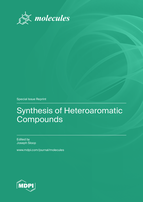Synthesis of Heteroaromatic Compounds
A special issue of Molecules (ISSN 1420-3049). This special issue belongs to the section "Organic Chemistry".
Deadline for manuscript submissions: closed (31 December 2022) | Viewed by 44874
Special Issue Editor
Special Issue Information
Dear Colleagues,
Heteroaromatic molecules serve as critical components of pharmacophores and other industrially important materials. New approaches to the preparation of both single-ring and fused-ring heteroaromatic species have been the subject of intense exploration over the past decade.
In this context, synthetic organic chemistry plays a key role and constitutes a flexible tool by providing access to a wide variety of compound types, including azoles, furans, pyrroles, pyridines, pyrimidines, and quinolinoids, to name a few. Through the variation and selective positioning of functional groups within the heteroaromatic molecular architecture, it is possible to modulate the properties of these compounds, which can yield substantial medicinal and industrial value. Additionally, the application of environmentally responsible synthetic processes to the preparation of heteoraromatics has burgeoned over the last decade. To that end, original research articles and reviews regarding recent advancements in the design and synthesis of heteroaromatic compounds of interest, especially those which highlight application of green chemistry principles, are welcomed for inclusion in this Special Issue of Molecules.
Prof. Dr. Joseph Sloop
Guest Editor
Manuscript Submission Information
Manuscripts should be submitted online at www.mdpi.com by registering and logging in to this website. Once you are registered, click here to go to the submission form. Manuscripts can be submitted until the deadline. All submissions that pass pre-check are peer-reviewed. Accepted papers will be published continuously in the journal (as soon as accepted) and will be listed together on the special issue website. Research articles, review articles as well as short communications are invited. For planned papers, a title and short abstract (about 100 words) can be sent to the Editorial Office for announcement on this website.
Submitted manuscripts should not have been published previously, nor be under consideration for publication elsewhere (except conference proceedings papers). All manuscripts are thoroughly refereed through a single-blind peer-review process. A guide for authors and other relevant information for submission of manuscripts is available on the Instructions for Authors page. Molecules is an international peer-reviewed open access semimonthly journal published by MDPI.
Please visit the Instructions for Authors page before submitting a manuscript. The Article Processing Charge (APC) for publication in this open access journal is 2700 CHF (Swiss Francs). Submitted papers should be well formatted and use good English. Authors may use MDPI's English editing service prior to publication or during author revisions.
Keywords
- heteroaromatics
- regioselective synthesis
- chemoselective synthesis
- azoles
- indoles
- quinoline
- pyridines
- solvent-free reactions
- green chemistry
- cyclization
- multicomponent reactions
- photochemical synthetic methods







